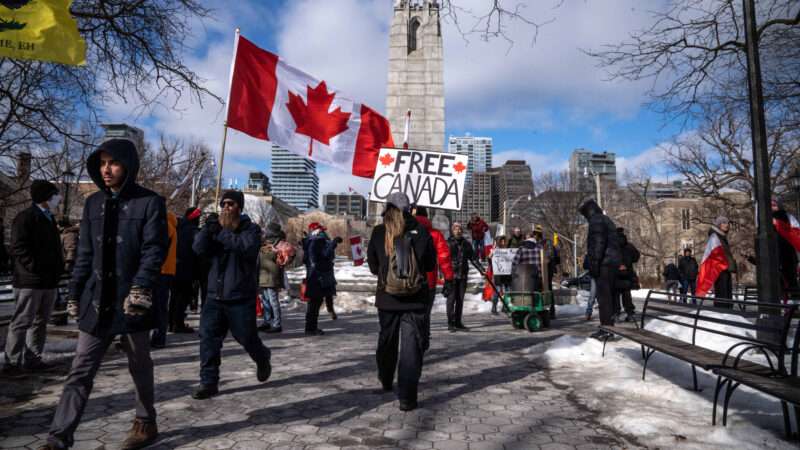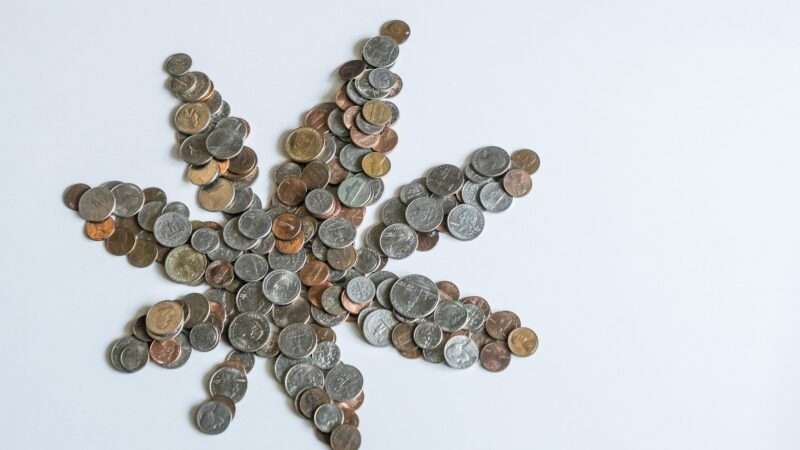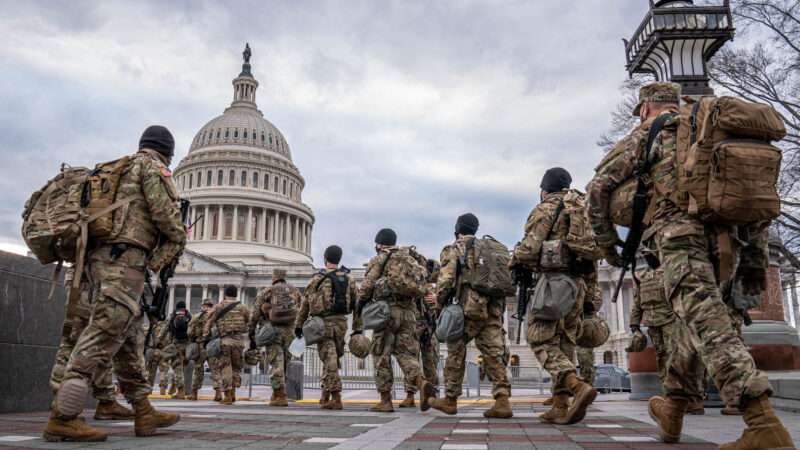On February 4, the U.S. State Department approved new proposed weapons sales to Saudi Arabia, Jordan, and the United Arab Emirates. If the deals aren’t blocked by Congress, the three nations will receive fighter jets, guided missile tail kits, and reinforcements for missile defense systems, among other spare parts and munitions. The UAE transfer, the Pentagon said, “will support the foreign policy and national security of the United States.”
While officials in Washington were approving those deals, bombs were falling half a world away on Sana’a, Yemen. Jets constantly buzz over the city, with airstrikes hitting rebel areas and civilian neighborhoods alike.
Sukaina Sharafuddin is a mother and humanitarian aid worker who lives in Sana’a with her 6-year-old son, Elias. For Elias’ whole life, Sharafuddin has been trying to keep him safe from the chaos outside. “I feel that I’m protecting him somehow, although that’s not true,” she explains. “But at least if I hear warplanes hovering still close by, or louder than usual, I would move him to our other location, which is the kitchen floor…inside and as far away from windows as possible.”
Since the city’s airport closed in 2016, only warplanes fly the sky over Sana’a. Sharafuddin’s son used to jump up and down excitedly whenever he heard them. “But now that he is six,” says Sharafuddin, “he hears the explosions and asks a lot of questions that I don’t know how to answer.”
Sharafuddin found out she was pregnant with Elias just one week before a conflict embroiled her country. She had to go to three different hospitals before finding one with electricity. As doctors were about to perform a cesarean section, she explains, “I asked to have a general anesthetic because I didn’t want to hear the sound of bombs when my son was born. So war has been part of his life, right from the start.”
The strikes Sharafuddin and so many of her countrymen dread are part of Saudi Arabia’s campaign in the Yemeni Civil War, which has raged for over seven years. But they are also a product of American involvement, through weapons transfers, logistical support, and financial assistance.
On the campaign trail, then-candidate Joe Biden promised to “end our support for the Saudi-led war in Yemen.” A year into his presidency, however, little has changed. The U.S. continues to arm the Saudi-led coalition, and Yemen is teetering on the brink of collapse. Under Presidents Barack Obama, Donald Trump, and now Biden, American military support has enabled the destruction of an entire country.
“Things are just escalating very quickly day by day,” says Sharafuddin, “and [Biden] doesn’t seem to be doing anything.”
“Hell on Earth”
The Yemeni Civil War began in 2014 and has since evolved from a domestic struggle for the country’s presidency into a complex, multipronged conflict that has drawn in some of the world’s major military powers—including the U.S.
In the wake of a struggle for the presidency of Yemen, the Houthi rebels, an Iran-backed armed Islamist militant movement known formally as Ansarallah, began to fight against a Saudi Arabia–led coalition that had Western backing. The Saudi-led coalition included 10 countries upon its formation and hoped to return its preferred man to Yemen’s presidency. Former President Obama offered American military support. U.S. forces were present on the Saudi Arabia–Yemen border for a time, but America’s role has for the most part been limited to logistics and intelligence support rather than boots-on-the-ground involvement.
At first, Obama justified U.S. support as a necessary move “to defend Saudi Arabia’s border”—coming to the aid of a historical, albeit questionable, ally—and “to protect Yemen’s legitimate government,” a less straightforward U.S. security interest. Washington’s support for the coalition soon came to involve significant arms assistance, a hallmark of U.S. involvement in the Yemeni Civil War that continues through the current administration.
Over seven years ago, Saudi officials guessed that it would take only a few weeks to quash tensions in Yemen. Not so.
Freelance journalist Naseh Shaker, who is based in Sana’a, points to some issues behind ongoing tensions. The former Yemeni president’s regime “used to set up camps and rocket storerooms on the outskirts of the capital,” in areas like “Noqm Mountain and inside neighborhoods like Al-Hafa camp. Launching airstrikes targeting these camps is to intimidate and terrorize civilians.” But the Houthi movement “no longer uses these camps,” he says, even though they have “been targeted monthly since March 2015.”
“Neighboring countries are fighting us and cannot accept us as refugees or do as Turkey did with Syrians,” he continues. “Saudis and [the] UAE want to fight in Yemen using Yemenis and are not ready even to welcome civilians as refugees nor ready to open Sana’a airport for sick people.”
“East or West, home is best,” he says. “Not because living conditions are better, rather I think because no country can welcome us in a hospitable way as we generously welcome others.” Yemenis must make do where they are because “there’s no other option.”
The past seven years, Shaker explains, have turned his country into “hell on earth.”
“There’s no escape,” says Sharafuddin. “People like me—civilians who just want to live a peaceful life with their family—they cannot escape it, because Yemenis are not wanted around the world. We cannot go anywhere without a visa, even Arab countries. Even if you get out, no country will let you seek asylum.”
American politicians have pointed to many reasons as to why the U.S. should remain involved in the Yemeni Civil War. Some have argued that it is an opportunity to “prevent Yemen from turning into a puppet state of the corrupt, brutish Islamic Republic of Iran.” Others stress that the Houthis have endangered American soldiers in the region, while some have emphasized the importance of maintaining the alliance with Saudi Arabia.
No matter the explanation, Yemeni civilians are hopelessly caught in the middle of warring forces that have a great appetite for conflict.
And American weapons have, in large part, enabled the destruction of Yemen.
“We were so hopeful, and we were praying so hard.”
Throughout Obama’s presidency, the U.S. approved more than $100 billion in arms sales to Saudi Arabia. His administration oversaw the transfer of “everything from small arms and ammunition to tanks, attack helicopters, air-to-ground missiles, missile defense ships, and warships” to the kingdom. “But as the death toll and reports of human rights violations in the Saudi-led war on Yemen began to rise dramatically,” reported Vox, “the Obama administration nixed the sale of the precision-guided munitions it had originally agreed to put in the deal to try to coerce the Saudis into curbing those atrocities.”
Former President Trump had no such reservations. His administration approved a litany of massive weapons sales. On his first presidential trip abroad in 2017, Trump announced a deal with Saudi Arabia worth $110 billion immediately and $350 billion over the following decade. The administration notified Congress of its intent to send almost $500 million of precision bombs to Saudi Arabia in December 2020, despite strong resistance among lawmakers to similar deals.
Obama and Trump’s support for the Saudis wasn’t exactly unprecedented. The U.S.-Saudi relationship has official roots in 1945, making it the longest American relationship with an Arab nation. During a high-level meeting that year, America committed to providing security, while the kingdom promised access to its oil resources. U.S. presidents have been reluctant to challenge the relationship, seeing Saudi Arabia as a key ally in a neighborhood where America isn’t always welcome. This has also made them reluctant to challenge the kingdom’s nasty conduct—its involvement in the killing of Washington Post columnist Jamal Khashoggi, its oppressive blockade of Qatar, and its chaotic military engagement in the Middle East.
From 2016 to 2020, Saudi Arabia accounted for 24 percent of all U.S. arms sales, while the U.S. supplied 79 percent of the kingdom’s major conventional weapons. Saudi Arabia is America’s top weapons buyer, and America is Saudi Arabia’s top weapons supplier. Saudi Arabia and its coalition partners have used American arms to strike Houthi targets, killing thousands of rebel fighters. But civilians have disproportionately borne the costs of these campaigns. In 2017, the U.N. Human Rights Council reported that the Saudi-led coalition had caused more than 60 percent of civilian deaths in the conflict.
In her capacity as a humanitarian aid worker for Save the Children, Sharafuddin witnessed the aftermath of one of the most infamous coalition strikes on civilians: a 2018 attack on a school bus that left at least 26 kids dead. Her team visited the survivors and tried to help however it could, but she notes that “the help is always limited due to the shortage of funding and because the needs are always high.” When they met the surviving kids again a year later, “some of them still had shrapnel in their head.”
In October 2016, the Saudi-led coalition carried out an airstrike on a funeral ceremony in Sana’a, killing at least 100 people and wounding over 500. Human Rights Watch (HRW) reported that U.S.-produced weapons were used in this attack and in an April 2016 strike on a market that killed at least 97 civilians, including 25 kids. HRW wrote two years later that American arms were found at the sites of dozens of “other unlawful coalition attacks in Yemen.” All the while, arms deals funneled money into the pockets of American defense firms like Raytheon and Lockheed Martin.
Every Yemeni profiled in this piece says these weapons are major fuel in the fire destroying their nation. “The US can’t be a peace advocate while selling weapons to UAE and Saudi Arabia,” says Shaker. The “administration—not the people—needs to change its words into actions because the world is watching.”
“The American audience should hear that they have to…ask their government to stop this war, to stop selling arms to Saudi [Arabia]…and the UAE,” says Ahmad Algohbary, a freelance journalist and founder of the grassroots humanitarian aid organization Yemen Hope and Relief. “They have to stop this. I know that people will lose their jobs when this war ends,” due to scrapped arms contracts. “We know that will not build their economy, but what about us?”
American weapons have been dangerous enough in the hands of allies—but our enemies have acquired them, too. A 2019 CNN investigation found that “Saudi Arabia and its coalition partners have transferred American-made weapons to al Qaeda-linked fighters, hardline Salafi militias, and other factions waging war in Yemen, in violation of their agreements with the United States.” Iran-backed rebels also acquired American arms, putting U.S. military technology at risk. Saudi Arabia and the UAE used U.S.-made arms “as a form of currency to buy the loyalties of militias or tribes, bolster chosen armed actors, and influence the complex political landscape,” according to CNN’s sources.
It looked as though things might change under the Biden administration. In a November 2019 presidential debate, then-candidate Biden cast Saudi Arabia as a “pariah,” criticizing Trump’s coziness with the kingdom. “I would make it very clear we were not going to in fact sell more weapons to them,” he explained. He said he would end “the sale of material to the Saudis where they’re going in and murdering children.” Upon taking office, he announced the end of U.S. support for the Saudi-led military campaign in Yemen.
Sharafuddin says that just about everyone she knew followed the election as carefully as if they were in the U.S., watching it unfold over television, radio, and social media. “We were so excited when Biden said that if he was elected as the president of the United States, he would stop the war in Yemen and he would stop selling arms to Saudi Arabia,” Sharafuddin recalls. “We were so hopeful, and we were praying so hard, everyone was praying that Biden would be selected, thinking that he would come to the rescue.”
But in December 2021, “the Biden administration pushed an additional sale of missiles to Saudi Arabia through Congress, arguing that the weapons would be used for ‘defensive’ purposes,” the Quincy Institute’s Trita Parsi and Annelle Sheline wrote in The New Republic. That supposedly comported with Biden withdrawing U.S. support for Saudi “offensive operations” in Yemen. His administration, seemingly committed to holding Saudi Arabia accountable and helping ease tensions in Yemen, condemned a December Houthi attack—but has not commented on the Saudi-led coalition’s bombings of Sana’a. As recently as last month, the coalition has killed civilians in internationally condemned strikes. A controversial January attack on a prison involved a bomb manufactured by Raytheon. Despite Biden’s campaign trail promises, America is still enabling the murder of civilians in Yemen.
“Honestly, I don’t know what to say. Now what?” asks Sharafuddin. “We thought that he would be better than the former presidents. But it is just disappointing, and it’s such a big lie.”
A September 2021 United Nations report “said the continued sale of weapons to both sides of the war has exacerbated the fighting.” Nations “that have continued arms transfers to Yemen are Canada, France, Iran, the United Kingdom and the United States.”
“I have seen death. I have seen hunger. I have seen everything.”
According to a United Nations Development Programme (UNDP) estimate, the conflict led to 377,000 deaths by the end of 2021. Nearly 60 percent of those stemmed from unreliable access to food, water, and health care. Airstrikes only added to the death toll—in September 2021, a U.N. panel estimated that at least 18,000 Yemeni civilians had been killed or wounded by airstrikes since 2015. U.N. experts informed the Human Rights Council that Yemenis had endured roughly 10 airstrikes per day since March 2015, amounting to over 23,000 total attacks.
A devastating cholera outbreak infected over 1 million Yemenis and killed 3,000 between 2016 and 2021, and COVID-19 has ripped through the largely unvaccinated population, killing thousands. Due to the ravaged medical system, it is extremely difficult to ascertain infection rates and death tolls with any precision.
The worst of the war has disproportionately landed on Yemen’s most vulnerable. Early last year, the U.N. projected that “half of children under five in Yemen” could suffer from acute malnutrition in 2021, with 400,000 expected to endure severe acute malnutrition. Minimal access to routine immunization and health services, malnourished breastfeeding mothers, and unstable sanitation systems all put Yemeni kids in danger. In 2021, a child under the age of five died every nine minutes in Yemen due to the ongoing war. These factors combined have made Yemen “one of the most dangerous places in the world for children to grow up,” per the U.N.
Algohbary has a deep understanding of his country’s suffering. “I have seen death. I have seen hunger. I have seen everything,” he says. When visiting attack scenes of airstrikes to offer assistance, he says, “I saw blood. I saw body parts. I saw very horrible things.”
His organization has provided food baskets, blankets, and school supplies to thousands of suffering families—but it all started with just one.
A famine ripped through Yemen after the war began. “Once, I decided to stay with a family, to know what they are suffering from,” he says. “I stayed from the morning until the night with them, and I slept there. Imagine, they had only flour and they mixed this flour with water, and after they mixed it, they ate it.” Algohbary says he saw the family “eating tree leaves to survive.” He returned home crying.
“Every day since that day, I swear that I’m always thinking about them when I eat anything,” says Algohbary.
He began to tweet the stories of his suffering countrymen, and his devastating photos and documentation garnered international attention. “I didn’t think that people would help me,” he recalls—but he started receiving donations from far and wide. With those funds, he and his team at Yemen Hope and Relief have distributed food and conducted “more than 20 water well projects.”
Even as Algohbary recovers from a surgical procedure outside Yemen, his team is carrying on humanitarian work. Especially critical these days are the organization’s efforts to bring malnourished children back to health. “For a kid, it’s really hard,” he explains. A baby born in Yemen “is born to a hunger ward…in a warzone, in the worst humanitarian crisis in the world, in the worst place to live as a child.”
Algohbary has helped heal 360 malnourished Yemeni children and brought critical supplies to many communities. He says he has been happy to provide so much help. More importantly, though, he hopes for remedies to the war’s deep, complicated roots.
“As Yemenis, we want this war to be over,” he says. “We want these countries—the U.S. and other Western countries—to stop…refueling this war.”
“I really believe that the Yemeni war will be over when the U.S. decides to stop it,” says Algohbary. “They have to stop this.”
Until then, his work continues.
“If the U.S. wants to stop this war, they can do it in just one call.”
Last year, the U.S. sold more than $1 billion in weapons to Saudi Arabia. The Biden administration continues to offer the kingdom logistical support in the form of maintaining and servicing Saudi fighter jets. The line between “defensive” and “offensive” support, it turns out, is easy to manipulate.
In the last month alone, Yemen has faced reduced food assistance, airstrikes on hospitals and critical infrastructure, and a nationwide four-day internet outage. A yearslong land, sea, and air blockade imposed by the Saudi-led coalition has kept critical goods from reaching the Yemenis who need them. Peace advocates have called on the U.S. to pressure Saudi Arabia into relaxing these measures—but Biden officials aren’t pushing the matter. “It is not a blockade,” a State Department spokesperson argued last April. January was the deadliest month in Yemen since 2018, with nearly one civilian injured or killed every hour.
“What has been happening during the last few days [in Sana’a] is similar to what has been happening since 2015. Hearing warplanes hovering overhead has become part of our daily routine,” says Shaker. “I don’t know if a military camp, a civilian object, or myself may be targeted.”
Some American lawmakers realize that little has changed on the ground in Yemen, even as three different presidential administrations have overseen U.S. involvement in the conflict. In September, a bipartisan majority in the House voted to end U.S. support for Saudi Arabia’s campaign through the National Defense Authorization Act—the third year running. However, the provision did not end up in the final bill.
Last week, Reps. Pramila Jayapal (D–Wash.) and Peter DeFazio (D–Ore.) wrote in The Nation that they intended “to pass a new Yemen War Powers Resolution” in order “to reassert Congress’s constitutional war powers authority, terminate unauthorized US involvement in this endless war, reinvigorate diplomatic efforts, and ease this devastating humanitarian disaster.”
Seven years’ worth of damage has left Yemenis weary. “I think if the U.S. wants to stop this war, they can do it in just one call—to call Saudi Arabia and the UAE to end it,” Algohbary emphasizes. Gather all the warring factions in Yemen and begin the peace process, he implores the Biden administration. “I lost friends, I saw famine, I saw blood. I have lived through every bad thing happening in Yemen.”
“Our message to the Americans themselves, to the international community, is that enough is enough with Yemen,” says Sharafuddin. “It is already bad enough as it is. It will take us years and years ahead to overcome the things we’ve been through.”
“We need peace,” says Algohbary. “We need peace.”
The post Biden's Hidden War Is Destroying Yemen appeared first on Reason.com.
from Latest https://ift.tt/vEeWp8w
via IFTTT






